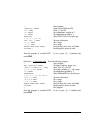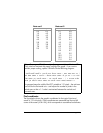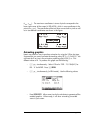
Page 22-20
PICT
This soft key refers to a variable called PICT that stores the current contents of
the graphics window. This variable name, however, cannot be placed within
quotes, and can only store graphics objects. In that sense, PICT is like no other
calculator variables.
PDIM
The function PDIM takes as input either two ordered pairs (x
min
,y
min
) (x
max
,y
max
)
or two binary integers #w and #h. The effect of PDIM is to replace the current
contents of PICT with an empty screen. When the argument is (x
min
,y
min
)
(x
max
,y
max
), these values become the range of the user-defined coordinates in
PPAR. When the argument is #w and #h, the ranges of the user-defined
coordinates in PPAR remain unchanged, but the size of the graph changes to #h
× #v pixels.
PICT and the graphics screen
PICT, the storage area for the current graph, can be thought of as a two
dimensional graph with a minimum size of 131 pixels wide by 64 pixels high.
The maximum width of PICT is 2048 pixels, with no restriction on the maximum
height. A pixel is each one of the dots in the calculator’s screen that can be
turned on (dark) or off (clear) to produce text or graphs. The calculator screen
has 131 pixels by 64 pixels, i.e., the minimum size for PICT. If your PICT is
larger than the screen, then the PICT graph can be thought of as a two
dimensional domain that can be scrolled through the calculator’s screen, as
illustrated in the diagram shown next.
LINE
This command takes as input two ordered pairs (x
1
,y
1
) (x
2
, y
2
), or two pairs of
pixel coordinates {#n
1
#m
1
} {#n
2
#m
2
}. It draws the line between those
coordinates.
TLINE
This command (Toggle LINE) takes as input two ordered pairs (x
1
,y
1
) (x
2
, y
2
),
or two pairs of pixel coordinates {#n
1
#m
1
} {#n
2
#m
2
}. It draws the line
between those coordinates, turning off pixels that are on in the line path and
vice versa.


















